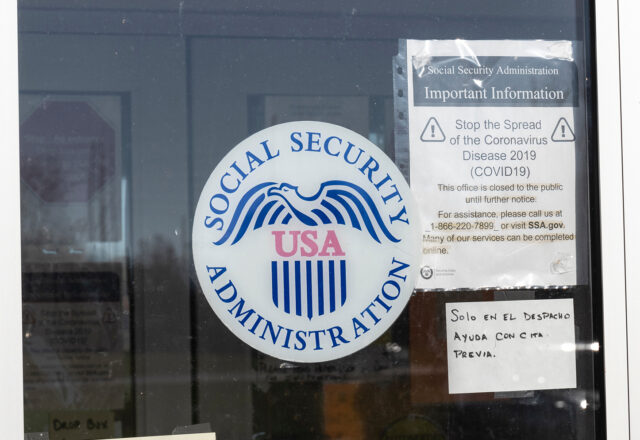
Money, Virus Angst Combine for Low-Paid
There’s COVID-19 stress, and then there’s money stress. The combination of the two is becoming too much for many low-income workers to bear.
Two out of three people in families that earn less than $34,000 a year told the U.S. Census Bureau in April that they are “not able to control or stop” their worrying several days a week or more. The feelings are the polar opposite for families earning more than $150,000: two out of three of them said they are not worried at all.
The daily blast of pandemic news has pushed U.S. inequality into the spotlight, exposing the financial pressures low-income Americans are dealing with. Despite the unprecedented $3 trillion in financial assistance passed by Congress, the anxiety was probably a contributing factor in the protests that erupted in dozens of U.S. cities last week.
When governors shut down their economies to control the pandemic, the lowest-income workers – disproportionately African-American and Latino – had barely recovered from the previous recession. Yet nearly half of the increase in incomes for all U.S. families over the past decade has gone to the 1 percent of families with the highest earnings. One glaring example of this disparity is homeownership, which is usually the largest form of wealth by the time people reach retirement age. Homeownership rates across the board declined after the financial crisis, but African-American and Latino rates fell more and are still below 2007 levels.
Low-income workers are now bearing the brunt of the current downturn. Economists estimate the true U.S. unemployment rate could be as high as 20 percent. The layoffs have been concentrated among low-wage workers: nearly 40 percent of people living in households earning less than $40,000 have lost their jobs.
The fundamental challenge of surviving from day to day is evident in the miles-long lines of cars at some U.S. food banks. About a third of Americans are having problems paying for all kinds of essentials – rent, utilities, or food – but the number rises to almost half for African-Americans and Latinos, according to a Kaiser Family Foundation poll in mid-May. Children are being disproportionately impacted by rising food insecurity.
Spotty health care coverage is another layer of stress. Workers on the front lines in nursing homes, meat processing plants and grocery stores are more at risk of contracting COVID-19 but less likely to have health insurance from their employers. They may avoid seeing a doctor, even if they have symptoms, out of fear of being unable to afford the charges.
Congress provided some protections for people needing treatment for the virus but did not cover hospital care. The federal Medicaid program insures millions of low-income workers. Yet low-income workers are over-represented in some of the states – Mississippi, Alabama, South Carolina – that have not expanded their programs to cover more residents.
The financial stresses are taking a toll on Americans’ mental health as they cope with depression and anxiety. And, again, low-income workers are more at risk.
Mental health was linked to financial health in one study several years ago that was based on interviews with service workers by the University of California, Davis. The researchers found that depression and declining mental health became more prevalent as the workers’ material hardship increased.
We are all trying to manage an extraordinary set of personal circumstances during this pandemic. But the levels of suffering – like the imbalances in income and wealth – are not equal.
Read more blog posts in our ongoing coverage of COVID-19.
Squared Away writer Kim Blanton invites you to follow us on Twitter @SquaredAwayBC. To stay current on our blog, please join our free email list. You’ll receive just one email each week – with links to the two new posts for that week – when you sign up here. This blog is supported by the Center for Retirement Research at Boston College.
Comments are closed.







Look at the cars in the photo. Cars I could only dream of. I hope the food bank is handing out copies of the CRR’s booklet “Curious Behaviours” along with the food parcels.
So after reading about 25 books on economics since retiring around 10 years ago, here is my take on this situation. First congress passes laws favoring wealth and high income workers IE capital gains tax and carry forward interest for billionaires; wealth is created by investing especially in the stock market (think Buffet) and low income persons have zero money to invest. Another factor unions do not want to talk about is public education, which has failed millions in the US in public schools for generations. If you want the facts on that look up PISA testing — an international testing done with high school students in 170 countries every 2 years on reading, writing and math. US results have been falling for 30 years, now ranking in the 20’s. Enough said
Good article. The pandemic is laying bare so many disparities — in our economy, in health care, in education — and the anguish that accompanies them. Its brilliance, though, is how it’s making it crystal clear that we’re all connected, that we’re one “whole.” Sickness or weakness in any portion of this whole impacts the entire system. We can never go back to the old “normal” and I’m glad we can’t.
It has been shown over and over that the “social determinants of health:” income, access to healthy food, green spaces, education – have a much greater impact on health than the traditional health care system. A living wage is the best medicine. We can and must reduce the obscene income disparities between the “1%” and the bottom 50% of wage earners.
As an African-American (since the article brought that up), I can tell you that I’ve had a lifetime of experience in my nearly 65 years – I’ve been without wealth; I’ve had wealth. I like having wealth better. I understood early what it takes to make it in this society – training/degree/certification in a marketable, in-demand, well-paying occupation.
I know what it’s like working in a low-income job and I’ve lived in Section 8 housing. That experience led me to make the conscious decision that’s not where I wanted to spend the rest of my life – no matter what the statistics said was predestined for me.
My parents instilled in us the need for education beyond high school. But, being unable to afford it, I joined the Air Force and earned my associates degree; after separating from the military, I earned my bachelor’s degree (and later a masters degree) in computer science.
No one is predestined to poverty just because of the color of their skin. Every person makes choices and has their own path to take from where they are to where they want to be. (I chose the path less traveled……)
Be that person who becomes what he (or she) wants to be. Be that person who has a comfortable income; be that person who gets capital gains; be that person who can invest in the stock market; don’t remain a low-income person; choose a good K-12 school for your kids and stay involved with their education.
Successful outcomes result from making right decisions early-on so as not to derail opportunities. Otherwise, even the basics will be out of reach. Health care coverage as well as access to other opportunities are often attached to those choices.
This is not a zero-sum game. It’s not the wealthy against the non-wealthy. Just because you make a million dollars doesn’t mean that I can’t. Just because someone else is rich doesn’t mean that you and I can’t be. There isn’t a finite amount of wealth or income out there. Anyone can get theirs. The pie simply grows larger for however many do.
It’s up to each of us to adapt to the times, take advantage of opportunities, and make the right choices to get us where we want to be.
Hi, thank you for writing an excellent blog. It has been shown over and over that the “social determinants of health:” income, access to healthy food, green spaces, education – have a much greater impact on health than the traditional health care system. A living wage is the best medicine. We can and must reduce the obscene income disparities between the “1%” and the bottom 50% of wage earners.
A very insightful post. From the perspective of someone outside the US, I must say I am constantly astounded and at times dismayed at the huge inequality of American society. It seems the current pandemic, an event like no other, is really showing this up.
I would suggest the problems being experienced are certainly being exacerbated by your President. Who it seems has failed to leave the combative corporate culture behind and indiscriminately tweets juvenile thoughts to all and sundry. Doesn’t he see the damage he does! Obviously not.
It has been shown over and over that the “social determinants of health” are income, access to healthy food, green spaces, and education.